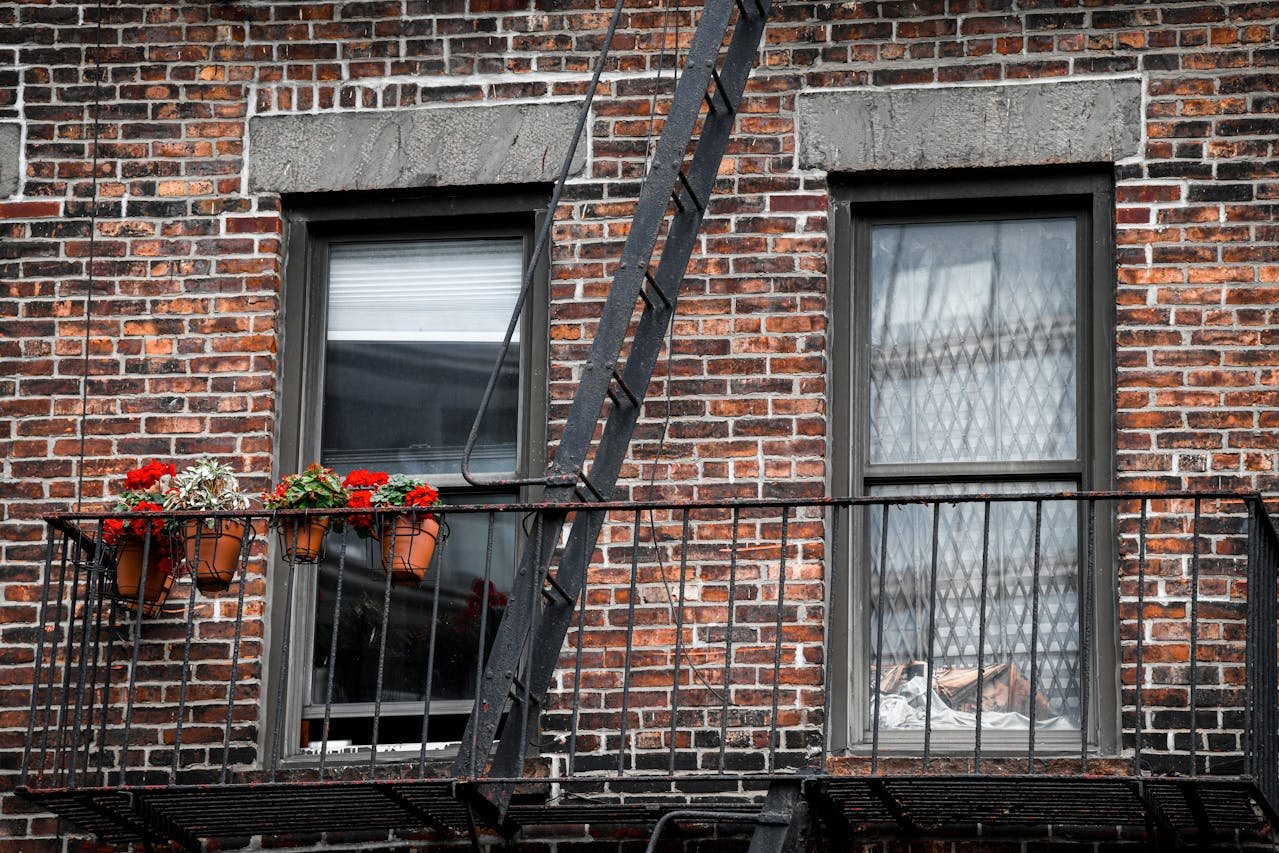
Photo by Reza Shokri.
Our new building has a fire escape. The kind you see in movies. Specifically the kind that’s in every Spiderman movie ever. And while the building is in Toronto, this part of it, metal, worn, vaguely precarious, looks like it belongs in Manhattan.
This morning, we made a pot of coffee. That’s not so unusual. This entire operation runs on caffeine. But instead of bringing our mugs to our desks, we sat out on the fire escape. Criss-cross applesauce on the top landing. Work clothes leaned up against the brick building. Hoping that whatever debris shook loose would be gone by the time we needed to be presentable for clients.
It’s fun to be up in the air in a city that doesn’t anticipate fire escapes. Not only was the people-watching exceptional, the breeze was, too. Last week, we had record heat up here. And if you are a person who keeps track of such things, record heat a lot of other places as well. So when the morning temp dipped enough to make coffee and fresh air a viable combo, we were ready.
Maybe you have a fire escape and maybe you don’t. Maybe you’re in an office building and maybe you’re at home with a snuggy over your lap. Maybe daycare kiddos have given you a teflon immune system and maybe the idea of snotty toddlers gives you the ick. It doesn’t actually matter for this next bit.
Learning and relearning
Regardless of how you get it, fresh air, it turns out, is very important. Modern humans keep relearning that you need to anticipate and build for airflow. It may seem like this would be a new, post-COVID finding. But it’s actually in the building code as a post-Spanish-flu finding. And not only as it relates to germs (though also that).
Our last office building was built about 75 years before the Spanish flu. Not only did the windows not open, someone had nailed them shut. With actual nails. By the afternoon, we’d notice that people in our programs were sorta sleepy. And before you throw any potshots, our very first assumption was that it was our fault. We get irrationally excited about management topics but not everybody does. So maybe they were bored?
Easy enough. We moved the most interactive modules to right after lunch. And even though folks were more engaged, it still felt like there was a film over the room. Next culprit was carbs. Maybe rice bowls and sandwiches were to blame? So off they go. Swapped for salads. And while both of these changes made for a better program, something still wasn’t quite right by the end of the day.
Allen et al. are no fun at parties
If you asked us to pick our favourite research paper on the cognitive impacts of air quality, we’d have to go for the classic. Allen, MacNaughton, Satish, Santanam, Vallarino, and Spengler’s 2015 paper, “Associations of Cognitive Function Scores with Carbon Dioxide, Ventilation, and Volatile Organic Compound Exposures in Office Workers: A Controlled Exposure Study of Green and Conventional Office Environments” is a barn-burner and if you’re encountering it for the first time, it will blow your damned mind. As a manager or a gatherer of people, it’s required reading.
If you sit with this paper and reflect on it, the first thing you get to is something you already know. That when the air is crappy, and stale, and it’s late afternoon, and you have a headache, it’s harder to think. Yes, good, fine, true. But if you push harder, you can get yourself to two much more important things.
The first is how important it is to put some numbers to this. Baseline outdoor carbon dioxide concentrations are generally around 400-500ppm. Indoor air tends to be higher because it’s full of humans, and CO2 is a thing we’re constantly breathing out. “How much higher?” is a function of a lot of things. Size of the space. Number of people. Are there windows or doors open? Is there a gas stove going? How good is the HVAC system? (Indoor plants are not as helpful with CO2 as you might hope.) But even in a big, well-ventilated space, indoor levels can get up to 800-900ppm pretty easily. And in a team meeting room, or a packed breakout session in a hotel event space, 1500ppm or more is a pretty reasonable expectation.
Which makes this sort of a bummer:
“Cognitive function scores were 15% lower for the moderate CO2 day (~ 945 ppm) and 50% lower on the day with CO2 concentrations of ~1,400 ppm … The exposure-response curve between CO2 and cognitive function is approximately linear across the CO2 concentrations used in this study…”
Like. A 50% decline in cognitive function? Seems bad? We talk to so many leaders whose companies are experimenting with different ways to work, and a common meta-pattern right now in 2024 is, “a lot of remote, but we come together sometimes as a team to work with each other in person.” Which is beautiful and so important and we’re here for it. But, like. Did you see Fig. 2 in that paper? What are we doing about the 50% decline in cognitive function?
Does your plan include air?
Everyone at RSG knows where the aranet sensors are. In the last month we’ve had a couple of groups come through our new HQ for multi-day programs, and someone is watching those readings like a hawk. Making sure the air is healthy, and supports hard work, is part of how we do our job. Yes the content, and yes the food, and yes the coffee and the seating and the light and the audio and a hundred other things we work very hard to get right. But also, vitally, making sure the air everyone’s breathing isn’t poisoning them.
Every space is different, and for you it might mean changes to HVAC, or opening windows, or propping the doors open on breaks. But you can only understand the impact of those actions if you can see the current state of things. There are lots of small, affordable CO2 sensors out there, and making the invisible visible is a powerful first step in making change for you and your team.
Because that’s the second important thing to take from this research: you can do something about this. It’s invisible and it’s tricky and it involves things you didn’t think you had to care about before, but air is a thing you can act on. And those actions matter. No one would knowingly schedule a two-hour strategy session in a room that, as a matter of biological fact, can’t support good strategy work for more than 20 minutes. But plenty of people do so without knowing. And, as leaders and as humans, we gotta cut that out.
And oh, btw, in case you were wondering. This doesn’t just apply to meeting rooms or hotel conference areas. How’s the air where you are right now? Working from home? Maybe with the windows closed and the AC on? Maybe with the door closed to keep the sound out on your fourth zoom call of the day without getting up? Ever find yourself sort of headachy in the afternoons after a day of that? When we first started using CO2 sensors in our work, we brought them home and the numbers were…surprising. But they also made an uncomfortable kind of sense.
Sometimes we ask bosses what helps them reset when they feel under it. Unsurprisingly, a lot of them talk about getting outside for a walk. Maybe it’s the time away from the computer. Maybe it’s the sunlight. Yeah, maybe.
Everyone always wants one weird trick to make the management and leadership stuff easy. We don’t have a weird trick for that. We have several tricks all stacked together. For the most part they aren’t even that weird. But cycling the CO2 out of a room so you and your people can actually think? Well, you’ll love this one weird trick.
— Melissa & Johnathan






